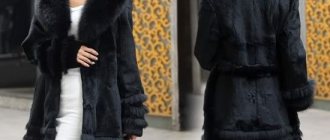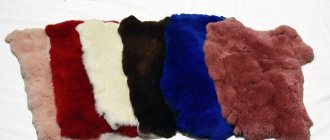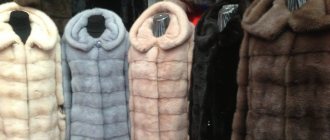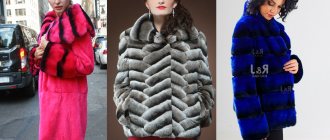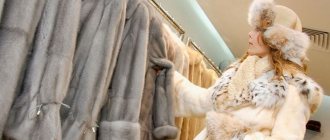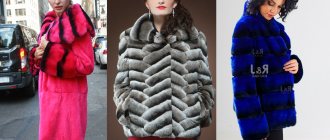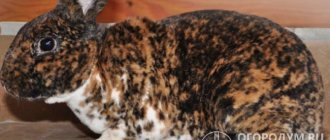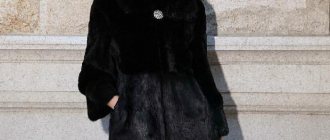Have you ever been sold a beaver fur coat at the price of a beaver?! The difference is several tens of thousands of rubles. Cunning sellers so lull vigilance with compliments that the “scam” can only be found at home. In a calm atmosphere, freed from hypnosis, you will check, read the Internet and understand what you actually bought.
Who were they in a past life, fur coats from a fur salon?
Comparison
As noted earlier, the first and most important difference is the wear period. The rabbit is able to “survive” for just a couple of seasons. Whereas the beaver can easily withstand all the hardships of weather conditions and can be worn for an average of eighteen winters.
However, it is difficult to imagine a person who would check fur in a store by asking the seller to wear it for such a long time. How to distinguish fur immediately so as not to become a victim of deception?
If you run your hand along the beaver fur along the fur, it is very soft, but in the other direction, you will feel the resistance of the fibers, some rigidity. Whereas a rabbit is silky, no matter how you stroke it.
Another distinctive feature is that the rabbit has very soft skin tissue, while the beaver is noticeably tougher, which is why it is valuable.
Please also note that the rabbit has a sparse undercoat, while the beaver has quite thick undercoat.
As for the flesh (the lower layer of the skin), if you rub it in your hands and it crunches, you have a rabbit; this is not the case with a beaver.
You can also distinguish a beaver by the geometry of the stitched skins; as a rule, they are rectangular in shape and the size is 40-50 cm, while that of a rabbit is 25-35 cm.
Table of wear resistance of different types of fur
Comparative wear resistance of various types of fur in points (the wear resistance of otter fur is taken as 100 points, which corresponds to 20 winter seasons)
| Otter unplucked | 100 |
| Wolverine | 100 |
| Otter plucked | 95 |
| Brown and black bear | 95 |
| Kamchatka beaver (sea otter) | 95 |
| Unplucked river beaver | 90 |
| Natural sea cat | 85 |
| Plucked river beaver | 85 |
| Nerpa (seal) natural | 80 |
| Natural sable | 80 |
| Nerpa (seal) painted | 75 |
| Natural raccoon | 75 |
| Leopard | 75 |
| Painted sea cat | 70 |
| Natural skunk | 70 |
| Natural mink | 70 |
| Soft natural marten | 65 |
| Sable tinted | 65 |
| Sheepskin | 65 |
| Painted raccoon | 60 |
| Astrakhan | 60 |
| Arctic fox blue | 60 |
| Natural wolf | 60 |
| Smushka | 60 |
| Painted skunk | 55 |
| Dyed mink | 55 |
| Painted soft marten | 50 |
| Natural mountain marten | 45 |
| Muskrat | 45 |
| Opoek | 45 |
| Korsak | 45 |
| White Arctic fox | 45 |
| Painted mountain marten | 45 |
| Natural fox | 40 |
| Painted wolf | 40 |
| Nutria unplucked | 40 |
| Opossum | 40 |
| Painted fox | 35 |
| Painted muskrat | 35 |
| Foal | 35 |
| Polecat | 35 |
| Natural lynx | 30 |
| Jackal | 27 |
| Natural squirrel | 27 |
| Fox painted black | 25 |
| Ermine | 25 |
| Columns | 25 |
| Nutria plucked | 25 |
| Possum painted | 20 |
| Wiesel | 20 |
| Lynx painted | 20 |
| Painted squirrel | 20 |
| sand squirrel | 20 |
| Marmot | 20 |
| Cat | 17 |
| Goat | 15 |
| Broadtail | 15 |
| Chinchilla | 15 |
| Rabbit | 12 |
| Mole | 10 |
| Muare | 10 |
| Common gopher | 10 |
| Chipmunk | 6 |
| Hamster | 6 |
| Brown hare | 5 |
We should not just talk about the wearability of fur, but distinguish between two concepts: wear resistance and wear time. The wear resistance of skins is determined by three properties: the strength of the fur itself, i.e. hair; the strength of the leather tissue, the strength of the bond between the hair and the leather tissue. The better all these properties are, the higher the strength of the skin and, consequently, the longer the wear life of a product made from such fur.
The approximate periods for wearing fur in seasons are indicated in the table (a season for fur clothing is considered to be a period of 4 months)
| Otter | 20 |
| River beaver | 18 |
| Sea seal | 17 |
| Mink | 10 |
| Sheepskin | 7 |
| Arctic fox | 7 |
| Marten | 7 |
| Seal | 6 |
| Astrakhan | 6 |
| Fox | 5 |
| Muskrat | 5 |
| Nutria | 5 |
| Squirrel | 4 |
| Marmot | 4 |
| Rabbit | 2 |
| Hare | 1 |
Specialist comments: “Since the research that resulted in this table being compiled, a lot has changed. What remains unchanged is the relative proportion of wear resistance by type of fur.
Today, the absolute wear resistance of products has decreased by more than half the table values. The decrease in wear resistance is explained not only by changes in animal feeding regimes, living conditions, and modern technologies for dressing and processing fur. The operating conditions of products have changed very significantly.
Previously, a fur coat was of great value and luxury; it was rarely worn, on special occasions, and the attitude towards it was accordingly. Today, clothing made from elite types of fur has moved into the category of everyday wear.
The use of products has become more intense and harsh, which, naturally, has significantly reduced the wear life. According to RPMS, the estimated duration of wearing mink products is now about 6 seasons (instead of 10 according to the old table), and in practice it may be even less.”
Definition
Mink fur attracts attention with its smoothness. He's shiny and short. It has a thick undercoat and coarse awns of equal length. Mink fur has a uniform dark brownish-brown color. The animal feels great on land and in water. For this reason, mink fur has excellent water-repellent properties. It is wear-resistant, practical and elegant. Mink is bred in Russia, North America, and Scandinavian countries. The quality of the fur also differs. The most valuable is the North American one, which feels like velvet.
Mink fur
Beaver fur is soft and fluffy. Thanks to the downy undercoat, it is very warm. The quality of wear of beaver fur is superior to mink. A fur coat made from this animal is not afraid of moisture, and becomes fluffier under wet snow. Plucked beaver fur is the most valuable. Usually a fur coat is sewn from solid square plates. The ridge is clearly visible on them. The pile is uniform and dense.
Beaver fur
Appearance
For all their apparent similarity, these furs are quite different. So... Rabbit fur - in appearance and to the touch, a product made from this fur is quite beautiful and silky. Its price category is low, but at the same time its wear life is comparatively shorter than that of other fur. In addition to its low cost, this fur is valued for its external similarity to beaver, chinchilla and mink. Today, many breeds of rabbits have been developed. Among them are the Chinese rex, the French orylag and the Australian. Therefore, the color range is very rich: there are noble gray and white tones, red-brown and just gray. But, despite the fact that the fur in the listed breeds is similar to “noble”, its quality remains at a low level.
Rabbit fur
Beaver fur is extremely popular nowadays. Used in the manufacture of luxury fur products. Among its positive qualities, one should definitely mention the special softness of the material, pleasant to the touch. It fits tightly to the figure and makes it more expressive. In addition, beaver fur has a very high fluffiness, which provides good protection from weather conditions, since such material is not afraid of moisture. It's just perfect for Russian winters. And in terms of wear resistance, fur has no equal: it does not go bald, does not fray or fade. On average, it is able to safely survive eighteen seasons. A wide range of colors allows you to choose the shade you like.
Beaver fur
Difference
First of all, pay attention to the geometry and size of the skins. In the beaver they are larger and have a square shape. Mink skin resembles an elongated rectangle. Even if the item has already been sewn, it will not be difficult to determine the shape of the skins.
The thickness of the flesh will tell you about the origin of the fur. For mink, this parameter is 1 – 1.5 mm, for beaver – 1.5 – 2.5 mm. The latter has a longer pile - up to 15 mm, mink - up to 10 mm.
Natural or lightly tinted beaver fur has a wide dark ridge, the belly and sides are usually lighter. It is impossible to get rid of this contrast even after bleaching the fur. Unlike beaver fur, the color of mink is very uniform.
A shorn beaver is identified by its prickly flesh. If its thickness, even after processing, is 1 mm or more, you can be sure that this is beaver fur and not mink. Most often, beaver fur is sheared, which is much cheaper than plucking. Since mink skin is initially expensive, it is processed using a more expensive technology - plucking. Are there “stumps” of guard hairs left in the fluff? In front of you is beaver fur.
With very good processing, beaver fur is difficult to distinguish from mink. And in terms of price, such skins will be more expensive and will be on par with mink. Don't forget to ask the seller for documents for the product, including a certificate of conformity. Perhaps these documents will help you find out whether this is a real mink or a sheared beaver.
